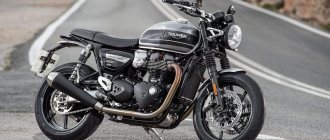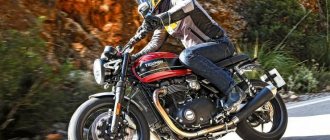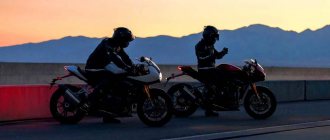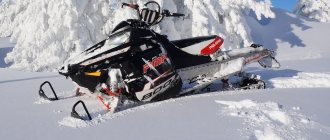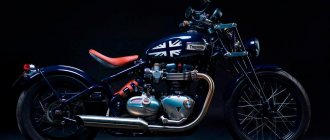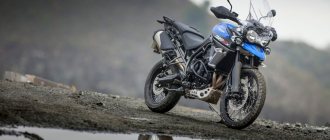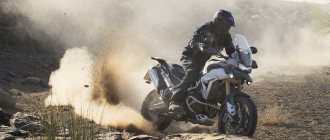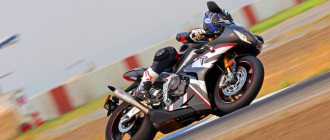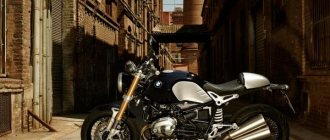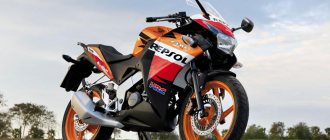Comparison test
Both are far from ideal for fast highway driving. That is, technically this is quite possible, but both of them lack even a hint of a windshield or fairing. The BMW R nineT has a lower handlebar, so the rider sits in a slightly more aggressive position, which helps it resist the wind better - and that's where the difference in aerodynamics ends. In a thick jacket and a good helmet in pleasant weather, you can safely go out on the highway without a windshield - the only pity is that there is no cruise control on both.
BMW R nineT and Triumph Speed Twin
The footpegs on the BMW R nineT are positioned ideally for a height of 170 centimeters. The cylinders, despite the air-oil cooling scheme, practically do not bake, the seat is a pleasant width, the knees comfortably cover the large 18-liter tank, and the suspension handles most bumps quite well. A significant part of the significant price of the BMW is the 46 fork with a full range of adjustments and a link rear suspension with a rebound adjuster and a convenient preload knob. Some of the earlier BMW R nineTs (remember, I said there are many different ones) are not very good on the road in terms of suspensions. And this one is completely okay. Over the past years, all glitches have been shaken out of its engine, which appeared back in 1993. 5000 rpm at 130 km/h is a bit short for such an engine, but it pulls well in any gear and at any speed. At some speeds and revs, noticeable vibrations make their way through the steering wheel, but they never reach or dry out your hands, and the engine sounds like a bumblebee (which is not surprising, given BMW's aviation past).
The BMW R nineT has a slightly lower seat than the Triumph Speed Twin, has a 5cm longer wheelbase, is equipped with a steering damper and rides on rails at high speeds - on very smooth and straight rails.
The Triumph Speed Twin is not quite as good as the BMW in terms of highway comfort, mainly due to its more upright stance, but the old-school 41 fork with two shock absorbers at the rear can’t compare with the BMW R nineT’s suspension. This, plus the lack of a steering damper, makes the Triumph's gait a little more wobble over small bumps.
BMW R nineT and Triumph Speed Twin seat
The narrow tank with a volume of 14 liters, which looked ideal at the Thruxton cafe, is too small here, including visually and between the knees. The footpegs are further forward and down compared to the Thruxton, but they still go back a little more than on the BMW, and the knees are noticeably bent more, especially if you sit right next to the tank. Luckily, the seat is flat and you can sit back and lean towards the steering wheel, making the riding position comfortable enough for high speeds. The narrow tank easily allows hot air from the engine to pass through, which is good on cool days, but not very pleasant on hot days. Of course, this heat cannot be compared with the early Indian Chieftain, which simply fried the rider in the most inappropriate places, but it’s still hot. And 14 liters with a consumption of almost 6 per hundred is not cool.
The Triumph series transmission transmits quite noticeable vibrations to the handles at 130 km/h (4500 rpm), but unscrew it a little and they go away. The cubic capacity makes itself felt: both motorcycles easily make their “ton” - i.e. 160 km/h, and then they accelerate only a little slower. I still don’t understand whether there is a speed cutoff on them, but in terms of revolutions it is at 7 thousand. However, there is no particular point in turning it up there; the engine outputs a maximum of 6600.
BMW R nineT and Triumph Speed Twin engines
BMW R nineT
The roadster, whose spectacular appearance is the exclusive merit of designer Ola Stenegard, is created on the basis of an air-oil “opposite” with a volume of 1170 cm3 (110 hp) and a six-speed gearbox from the R1200R roadster. Only the gear ratio is chosen “shorter”: 2.91 versus 2.75 - like the old “goose”. A non-adjustable inverted fork is installed at the front, and a monoshock absorber at the rear, adjustable by spring preload and rebound hydraulics. Of the electronic assistants - only ABS.
STORY
2014 For its 90th anniversary, BMW MotoiTad presented the neoclassic R nineT with retro motifs in design (in-house index K21). The engine is based on the 1170 cm5 air-oil boxer and six-speed gearbox from the R1200R roadster. Only the gear ratio is chosen “shorter”: 2.91 versus 2.75 - like the old “goose”. A non-adjustable inverted fork is installed at the front, and a monoshock at the rear, adjustable by spring preload and rebound hydraulics.
2016. From the “mother” R nineT, an “off-road” version of the Scrambler (K23) emerges, which was created by installing a traditional “telescope” with rubber corrugations, simplified instruments, a high steering wheel, alloy wheels of a different size (front - 19 inches) and an upturned “ double-barrel silencers. Spoke goose wheels and toothy tires are offered as options.
2017 The BMW R nineT family expands with three new variants. The most simplified Pure (K22) is a retro roadster, which has only the essentials: a regular telescopic fork, 17-inch cast wheels, a single muffler and a single speedometer. Vintage Racer (K32) - everything is the same, but with a semi-fairing, front and rear seats, full-fledged instruments and an aluminum “hump” instead of a passenger saddle. The Urban G/S SUV (KZZ) is a stylization of the already well-known Scrambler after the legendary R80 G/S: a high front fender, a “fly swatter” around the headlights and a characteristic coloring with a red saddle. The “regular” R nineT receives not only an “upside-down” damping adjustment, but also a “blunted” geometry.
It is significant that from the very beginning the Bavarians relied on the possibility of various personalization of the model, not only offering an extensive catalog of accessories and options, but also in every possible way encouraging any technical creativity based on Nine-Ti. So when such a successful model began to multiply with various modifications, no one was surprised.
The first to branch off from the “mother” R nineT (in-plant index K21) in 2016 was the “off-road” version of the Scrambler (K23), which was obtained by installing a traditional “telescope” with rubber corrugations on the existing platform (it’s not even a cartridge), simplified instruments, high steering wheel, alloy wheels of crossover size (front - 19 inches) and upturned “double-barreled” mufflers. It’s just a pity that spoked wheels from the “goose” and “toothy” tires, so appropriate on off-road, turned out to be available exclusively as an option.
And six months later, already in 2017, the BMW R nineT family takes its current form, having grown to five versions. The most simplified Rige (K22) is a retro roadster, which has only the essentials: a single color, a regular telescopic fork, 17-inch cast wheels, a single muffler and a single speedometer. Vintage Racer (K32) - everything is the same, but with a semi-fairing, clip-ons, full-fledged instruments and an aluminum “hump” instead of a passenger saddle. The Urban G/S SUV (KZZ) is a stylization of the already well-known Scrambler after the legendary R80 G/S: a high front fender, a “fly swatter” around the headlights and a characteristic coloring with a red saddle. The “regular” R nineT receives not only a “reverse” with damping adjustment, but also a “blunted” geometry: the fork angle has increased from 25.5° to 26.8°, and the base has increased from 1476 mm to 1487 mm.
From the gas cap to the tips of the mirrors, this motorcycle is filled with the spirit of “that time”, when everything was made of metal, and not of despicable plastic. It’s the new low-powered cars whose manners are smoothed, combed and subdued, while the nineT has the last of the air-oil Mohicans, without the godless water pump and radiators the size of a TV. The torque of the opposed 1170 cc “two” is spread throughout the entire range, starting from 2000 rpm. And at the same time, there are no driving modes - everything is concentrated in the right handle. Changing gears is an event. The old-fashioned “mechanics” do not like rushing. An attempt to accelerate without squeezing the clutch, clicking the gearbox up synchronously with the awakened rev limiter, in a classic BMW causes nothing but misunderstanding, which is why the gear change comes out jerky and stumbling. Therefore, you interact with it the old fashioned way: up with the clutch, down with the throttle. And what inertia from the rotation of the crankshaft with the cardan! You open the gas in an inclined position - and, depending on which direction you turn, the “opposite” tries to either zealously rise or fall even lower.
Solidity of sportbikes and street bikes? May it be for you! Those who asked for the “rebellious fifties”, get it and feel how the rear of the Nine-T kicks under aggressive shifts and changes in traction. Although the “Bavarian” is capable of being meek, if you don’t whip him with the throttle in vain. Then he, assisted by an inverted fork, will confidently draw a high-speed arc, and the only tilt limiter will be the cylinder covers.
However, BMW, even if it was created by people nostalgic for the past, but living in the modern world. Therefore, it is gifted with human ergonomics, Brembo radial calipers with ABS, a steering damper, and normal suspensions.
The opposed “two” air-oil cooling and all its weak points have long been known, and most have been corrected. And in general, it does not cause any global problems, but, as they say, there are still nuances.
For example, there are cases where in vehicles with mileages of more than 70,000 km, valves became stuck due to worn or broken springs, which led to them colliding with the piston. You can diagnose the symptoms of the upcoming “Stalingrad” at a scheduled maintenance. Moreover, it is necessary to set the thermal gap, to the value of which the “air vent” is extremely sensitive, every 10,000 km. How to synchronize the throttle valves, by the way.
Oil gluttony, albeit in extremely modest quantities, is considered the norm rather than the exception. Especially if the engine was run in too carefully, which is why the piston rings did not rub in properly, or if it was filled with oil of a lower viscosity than the recommended 15W50. So you have to regularly monitor the level through the viewing window.
Break-in, by the way, happens very slowly. Therefore, if you like a copy with a mileage of less than 5000-6000 km, then be prepared that the operation of the “air vent” may seem rough and vibration-laden.
Some owners complain that the boxer twin, especially on models with forward flow, can sometimes stall without good reason (most often when downshifting and idling). The problem is largely explained by the ultra-lean mixture, on which, in the name of meeting economic standards, a very old engine is forced to run, and this can be treated either by flashing the control unit or by installing a Booster-Plug device (a simplified analogue of the Power Commander).
The gearbox, like all “air” BMWs, has never been distinguished by either softness or clarity of shifts. And this is not so much due to the souring hinges of the shift rods as to the “old-mode” design of the “six-speed”. This means that when handling it you should be calm and persistent, although in this case, even in this case, engaging first gear or searching for neutral can take quite a long time—reversing the throttle with double-depressing the clutch saves the day. A single-disc clutch, by the way, if you don’t use it atrociously (don’t participate in drag races, don’t anneal the tires and don’t climb on the rear wheel again), can withstand up to 60-70 thousand km. Nightmares about crumbling bearings and chewed gears of the gearbox, which haunted more than one generation of “opposite” vehicles, seem to be a thing of the past. However, caution still doesn't hurt.
After all, one of the recall campaigns for the R nineT, produced between 2014 and 2022, related specifically to the cardan drive: the bolt that attaches the pendulum to the frame could become loose and lead to an accident.
The main electrical problem is the weak standard battery: it rarely survives to the end of the season. Moreover, periodic prevention using a pulse charger only partially saves, slightly delaying the moment when the motorcycle refuses to start when cold. It’s bad that a voltage drop in the network is fraught with the appearance of numerous errors in the system. Nine-Ti has a couple of outlets for connecting, say, navigation and an electrically heated vest. In addition, they are predictably “tailored” for cheap gadgets, which is why you will probably need an adapter to connect third-party devices. If there are more than two “additional stages”, then, taking into account the CAN bus used by the Bavarians, the wires will have to be connected strictly in certain places: directly to the battery, for example, or to the charging cable under the driver’s seat.
ENGINE
The opposition “two” air-oil cooling with a volume of 1170 cm3 and the “six-speed” went to the “classic” R nineT from the R1200R roadster. The power unit is generally reliable, although it does require some attention. Mechanics are aware of its extreme sensitivity to “floating” thermal valve clearances and out-of-step throttle synchronization, which is why checking and adjusting is required every 10,000 km. A certain amount of oil consumption is considered the norm, which means that the oil level has to be monitored regularly.
SUSPENSION
The owners of all versions of the BMW roadster have de facto one complaint about the suspensions: they are too simple for their class. Moreover, if the “regular” R nineT has more or less decent damping on an inverted fork with 0 46 mm stays (until 201/2019), the 43 mm “telescope” of other versions (it’s not even cartridge) is set to frankly measured okay The most common treatment is to replace the springs AND fluid in the fork along with purchasing a new monoshock.
BRAKE SYSTEM
Brembo radial calipers are exclusive to the top-end R nine! The rest use traditional 4-piston calipers of the same brand. The anti-lock braking system kicks in early, but generally correctly. By the way, the entire system should be pumped, which many (including official mechanics) are frankly too lazy to do. Retribution comes in the form of a dead ABS block.
TUNING
When it comes to customizing the R nineT, there are exactly two limits: your imagination and your wealth. In all other respects there is complete freedom. After all, the list of additional equipment and accessories in the factory catalog seems endless: from a banal tank bag to a set of milled parts from the Spezial line. And third-party companies (just remember Rizoma and Wunderlich) also did their best in creating options.
On the run
Let's be honest: overliters are not needed to drive slowly. Both handle this quite well, and it’s interesting how differently: the BMW boxer is an excellent engine, powerful and torquey, but the peak of its capabilities occurs at 3500 rpm. It has an almost automotive character, and it’s not even surprising that it is stubbornly equipped with a single-plate clutch. Due to the longer wheelbase and steering damper, the BMW turns a little less responsively, but it doesn’t wobble at every bump. This is felt on good asphalt, but is especially noticeable on uneven paths.
But the ability to accelerate alone is not enough; you also need to turn and brake. The 320's with radial calipers on the BMW R nineT are much more interesting than the Triumph Speed Twin braking system . Its 305 wheels, however, also stop the motorcycle quite adequately, but, as always, the devil is in the details.
brake system of BMW R nineT and Triumph Speed Twin
But the Triumph Speed Twin has an advantage when driving on small, winding roads. It's shorter, has a shorter fork offset, a higher center of gravity and a narrower rear wheel, so it's much quicker and more willing to turn. Yes, its suspensions do not smooth out bumps as well as the BMW, but they do a good job of keeping the motorcycle on line both in corners and when driving fast in a straight line. The six-speed gearbox and chain drive allow you to shift less often and smoother than the driveshaft on a BMW.
For those who find the Triumph's Sport riding mode too bouncy, there's a Road mode where the response is just as immediate and the traction is excellent right from the bottom. The engine runs smoothly and smoothly, and the seating position is optimal for leisurely rides along the highway.
The steering wheel of the BMW R nineT, in my opinion, is a little wide for a collected position, but despite the more nimble geometry of the Triumph Speed Twin and lower weight, the BMW steers quite on par with it , except that it requires a little more effort for this. On higher-speed sections, BMW could, if desired, overtake Triumph (however, as I already said, in terms of acceleration, their capabilities clearly exceed our needs)
So, the 2015 season has passed, it’s definitely already passed, and now we can fully and completely share our impressions, emotions, and generally tell you what it’s like to own the opposed, explosive, snappy and ostentatious BMW R1200 Nine T equipment.
I ask under cut There won’t be many photos, because there’s no need. I have an absolute stock without a single change or addition except for the protection of the engine cylinders. I’ll probably start with the fact that the motorcycle was purchased on the last day of February 2015, the motorcycle itself is 2014, and I was just lucky that it took a long time to arrive and the person did not wait for this motorcycle since mid-summer and bought an alternative from the same BMW model range. In general, the point is that it was simply impossible to come and buy this motorcycle in the summer. I don’t know because of demand (hardly) or meager quotas for Russia, but the fact remains that I got the motorcycle 100 thousand rubles cheaper than the price list, due to the fact that it was already “old” and the dealer was obliged to get rid of it for any money to get quotas for the new model year. Well, okay, these dealer problems didn’t bother me, the main result was that I was able to buy what I wanted. And yes, I really wanted this particular motorcycle. But because of its high and unjustified cost (that’s exactly how it seemed to me at the time), I went to the dealer to buy a BMW R1200R 2015 model year. Leaving an advance payment for a not very simple package, I heard about the “failed R NineT” and away we go... In general, that day the stars aligned and I bought a motorcycle without water cooling, without ESA, without heated grips, without LED headlights, without electric suspension, even without a mechanically adjustable fork, without an electronic throttle with two or three engine operating modes (depending on the R1200R trim level), without the ability to install an optional quickshifter, without a wet slipper clutch, without a tire pressure sensor, without an electronic multifunctional instrument panel and... list I could go on and on about little things. I had so many doubts after this decision. There is the same amount of money, but it’s nothing. Just a brain explosion and the feeling of a reckless act was eating me alive.
What's done is done, before this I already got burned by buying a Hyperstrada from Ducati, which was stuffed with everything you could want. However, this did not help the motorcycle remain in my hands; the feeling of “not mine” did not go away every ride while owning the Ducati. So, quietly and peacefully, my cockroaches in my head about goodies and electronic assistants calmed down and got on with other things.
Photos from the salon:
Now what can I say about the motorcycle after traveling 10 thousand km this season. The most important thing is that this is really a motorcycle, it’s really comfortable and it really rides well. This is not just a beautiful toy that should stand in a country house in place of an expensive vase from which the maid must periodically wash the dust. A motorcycle has passion, drive, a certain asceticism in behavior, and most importantly, character. Its own, not like other streets. And yes, it’s straights, not classics or anything similar to them or scramblers. Precisely because this motorcycle is much closer to liter street than to six hundred. To understand the seriousness and dynamics of this motorcycle, I rode several times with motorcycles such as the Honda CBR600RR and Yamaha R6. I’m ready to “answer for the market” and admit that I drove both of these motorcycles up to 150 km/h. Despite all this, I can’t boast of any drag skills or any sporting achievements on a motorcycle. This is far from my first season in the saddle, but I certainly don’t pretend to be the “fastest hand” on the wild Moscow Ring Road when it comes to squeezing the gearshift clutch and unscrewing the throttle. All this is said to mean that the motorcycle goes much faster than it might seem from its appearance. This is partly due to the large engine. 1170 cubic cm, even with a cut-off at 8 thousand revolutions, with a relatively few 110 horses and 115 Nm on paper, produces 3.3 seconds from zero to 100 km/h. In addition, the gear ratio in the box has been changed, with very shortened gears in comparison with the GS and RT models on the same engines, giving a noticeable advantage in acceleration. Well, the curb weight of the motorcycle is 222 kg, which is not so much for a high-torque boxer.
However, driving in this mode is never fun. This engine allows you to engage third gear in the morning without thinking about speed, drive all day through traffic jams and on the highway, and in the evening, before putting it in the garage, still switch to neutral. Already from one and a half thousand revolutions, the motorcycle can accelerate dynamically enough to overtake, but at the same time it behaves quite well and predictably at low speeds and does not twitch at relatively low speeds in upper gears. In general, a quiet riding mode in the region of 3-5 thousand rpm is the most fun on this motorcycle. A motorcycle can shoot at every traffic light, but I don’t want to do it.
Absolutely everything except short gears makes for a relatively quiet ride. The suspensions are quite rigid, but if the “race” mode is turned on in the head, then the ass understands, but not the BMW S1000R(RR) under the fifth point in the suspension. It handles the unevenness of Moscow roads and tracks perfectly, but this is not a sport and certainly not an enduro. Although, I must admit, in Nikolo-Lenivets, when getting to some art objects, I allowed myself to hang out on the paths and in some places even take off the ground quite well and fly a couple of meters. A sportbike would definitely not forgive you for this, but this is an excellent replacement for “Planet 5” in the countryside, I highly recommend it as a bike for the village. And it’s not a shame to go fishing and go to the village council in the regional center.
Landing does not cause any inconvenience. Probably, if you cut a thousand or one and a half thousand a day on it, you can install spacers for the steering wheel, making it two centimeters higher. The landing will become a little straighter, but in the city you don’t feel it at all and don’t want it. In my opinion, the handlebar-seat-pegs triangle is more suitable than ever for people 175 cm tall.
The width of the steering wheel is not like on touring crossovers, but again it is not a sport bike with clip-ons. In Moscow I feel very confident in traffic jams; there are no plans to change anything in this regard. Everything is fine and very functional. The mirrors again allow you to see not the pilot’s elbows, but the road conditions behind the motorcycle. But a friend on a water R1200GS has the same mirrors as me and he added a small spherical mirror to the extreme corner of each mirror, thus there are practically no blind spots at all. I also plan to try it out in the new season, let’s see the functionality.
This is roughly how I move in a traffic jam in not the best weather (the visor is covered in snow, I was going by instruments and by memory):
Let's take a look at driving outside the city. Again, everything is quite simple and without serious comments. The suspension is not telelever, as on the R1200RT you won’t be able to ride on ruts and smoke. This specimen is not so much a tram type, but the rutting is tolerated quite easily and without serious consequences. It’s suitable for tracks with mixed asphalt, but the same R1200GS on the road from Yaroslavl to Rybinsk (shame on such roads, gentlemen, governors, shame!) felt much better. The goose moved easily and unforcedly at 100-120 km/h, I, with swearing and choosing slightly better asphalt on the oncoming lane (whoever drives long distances in Russia knows very well that the asphalt on the oncoming lane is always better, even on the way back) drove 80-100 km /h and again felt like an endurist several times, flying up a couple of times with the wheels coming off. The suspension is not so energy-intensive, the goose is definitely a favorite in such terrain.
Rostov Veliky:
Rybinsk:
Uglich:
Just a beautiful field in front of Posad:
In terms of wind protection... Well)) It is a little better than on the 2008 R1200R, better than on the 2008 Honda Hornet, but exactly as much as a cappuccino differs from a mochaccino. You can drive 110-120 km/h all day, but 130 is no longer possible. Well, more accurately, it’s possible, of course, if your neck is wider than your waist and you treat your body with disgust. In short, in terms of wind protection, it’s not a tourist at all. However, personally, I get great pleasure from long runs at acceptable speeds. You may call me a pervert, but the “wind in the mug” is the right motorcycle for me.
Returning to the gearbox, I note that this unit in the motorcycle does not bother me at all. Switches clearly and clearly. I’m used to the passes, their length. I repeat, they are short, and at first they were puzzling. But then I realized the full meaning and advantages of this solution for a city motorcycle. The clutch is hydraulic, but the disc is dry and has a fairly large flywheel. So when spinning the engine while standing still, the effect of a roll to the right is present. But you shouldn’t believe in the fables about adding gas while turning and tipping the motorcycle to the right. Complete nonsense. When moving, you will not feel this design. This is no longer the case on opposed and water-cooled motorcycles with wet clutches. Also, on “wet opposite” the clutch is much softer. Again, everything is in comparison, any mechanical clutch (cable) will be stiffer than the clutch on the NineT. Also, on a wet opposite, the box turns on much softer and more gentle. I have a clear and sharp switching, it is always felt and felt. Unaccustomed to riding a water goose, I looked at the tidy to see if I had switched correctly. This point is clearly related to habit.
About the brakes! They are very good. They are so good that you can feel even more pleasure from braking than from acceleration. Brembo, reinforced hoses, ABS and independent circuit. For those in a tank, new BMW motorcycles are equipped with a dependent braking system with ABS. This means that when you apply the front brake, part of the braking force goes to the rear brake automatically, while the pilot does not touch the rear brake foot at all. Since 2014, all BMW motorcycles have been equipped with an ABS system, and this is the only electronic feature present in the NineT. It’s nice that a minimum amount of safety is present, but the ABS system only works in extreme cases. For an inexperienced pilot, I said it was extremely late. You can manage to lay down the bricks at the moment when the rear wheel is already half a meter from the road surface, and it seems that the front wheel has long been on the verge of failure, but ABS inexorably refuses to interfere with the process of controlling the motorcycle until the last. You can grab your feet in the summer on warm asphalt and heated tires like two fingers. In short, if you are sliding while braking, for example during a marking, then yes, ABS is right there, but you can still feel its work. You can notice the wheel drift. Maybe I’m being too picky and most people wouldn’t notice this, personally I always understand when the ABS system worked and when it wasn’t necessary and it didn’t interfere. You can feel the ABS on the rear wheel. And surprisingly on NineT the rear brake is not just for show. They really can and should be used. Sometimes, just for fun, I don’t use the front brake before stopping at a traffic light if I see 50 meters away that the light is red and the speed is within the speed limit set on the signs along the road.
A little about light. The headlight is installed as usual, i.e. reflector, halogen lamp with H4 socket (low/high in one lamp). There is nothing remarkable about it, except for the beautiful icon in the middle. Well, again, it shines much better than on a Honda and especially a Ducati. The light is scattered evenly, the far one differs from the near one as expected, i.e. The light switch button really works as it should and is not just for show (hello Ducati!). Although everything suits me, my hands are itching. So in the off-season I want to install a PHILIPS X-TREME VISION MOTO lamp. I saw how it shines, I really liked the temperature of the glow (I wear lenses, I’m a little nearsighted) and my eye perceives this particular light very well. This is my personal paddock.
The stock tires are great. Metzeler which allows a lot. And it holds turns beautifully, and allows you to decelerate “on your ears,” and in temperatures below zero it maintained grip. I am a dedicated motorcyclist and use the technique from the first snow in the spring until the first snow, which is no longer on the lawn but on the road. In terms of wear, the rubber is extremely resistant and on the previous BMW R1200R the rear tank honestly lasted 25 thousand. However, after a trip to Crimea and very hot asphalt, the rubber suddenly ran out. The mileage in Crimea alone in the heat is about 2 thousand. But there are no complaints about it, the Michelin Pilot 4 ran out twice as quickly with equal use. But Michelin is softer and holds better under critical loads. This is again my personal conclusion, maybe someone has the opposite opinion. The rear stop is diode, visible to drivers, there are no questions about it. Classic-looking turn signals with incandescent bulbs. Perhaps they will be changed to diode ones. There is no need, just another wish and awl in one place.
The speedometer and tachometer are absolutely classic in appearance. Two “wells” and between them, a little out of topic, according to most critics of this model, there is a very useful display. Yes, it may not fit into the design of this motorcycle, but personally I like the tidy. There is nothing superfluous on it, everything is extremely modest and has a classic look. On the dashboard you can see instantaneous consumption, average, mileage, two daily mileage counters and total mileage. A display of the gear engaged and a clock are also present. I don’t have heated grips, but they will be installed in the spring along with maintenance. Also, the inclusion and dual-zone operating mode of the handles will be displayed on the dashboard. When the fuel indicator lights up from above, there are 4 liters of fuel left in the tank (speaking of the tank, it is aluminum, no bags with magnets stick, but there is nothing to rust) and the mileage is switched on on the dashboard, which is counted from zero. You can drive about 70-80 km from the moment the light comes on. Quite convenient functionality.
Since we're talking about the tank, a few words literally. Aluminum 18 liters. Painted black, silver on the sides. The width is comfortable for me personally, not narrow but not wide either (on the previous R1200R I felt like I was saddled with a pregnant pony, it was a bit wide, my legs didn’t want to go perpendicular to the ground after a day of moving). The varnish on it is rubbed off and scratched, I will come up with something in the area of the tank-seat junction. Some kind of non-pretentious sticker.
I've probably described it enough. If you go through the motorcycle in general, then this is exactly what I have been looking for for so long. I literally like everything about it. Starting from the appearance and ending with the way it accelerates, steers, and brakes. With all its shortcomings in the form of missing wind protection, vibrations (in comparison with 4-cylinder in-line engines, of course they are present, but here there is a two-shaft engine and vibrations are much less than on the first variations of the boxer), the absence of any mud protection at the rear (this is just a fact, fact , you’ll ride like a pig on slightly wet asphalt), a clumsy, rough appearance, completely lacking new technologies (thanks to the ABS) - this is the best motorcycle I’ve ever owned or ridden. Please do not take these words as: “this is the most ideal motorcycle in the world”! As we all know, there is no such thing. But this motorcycle sunk into my soul, and while owning a motorcycle, the thought always wandered in my head: “I need to either change something or save up and buy something cooler, more powerful, faster, etc.” then with the acquisition of the BMW NineT I sometimes want a second motorcycle. Enduro, or tourenduro, but I don’t want to CHANGE this motorcycle for anything.
To summarize, I found what I wanted for so long. This was the first motorcycle that I bought not for my mind, not for technology, not for a powerful engine, but simply because I liked it. I liked it like no other. I believed in a miracle that I would like it even after purchasing it. And a miracle happened! My brain is not looking for something better, now I turn around every time to look at the motorcycle when leaving the garage. If only it were possible, I would say hello to him and say goodbye by hand)) All this reminds you of how in life, you have friends from school with whom you hung out cool. Then there was college, new friends appeared, new hobbies and your pastime changed. Then you graduate from college, acquire a new team around you, as well as new friends. The world around us is changing and changing. Now you already have a beloved wife, a child who is dearer to you than anything in the world. But with all this, you know that you have an old friend with whom you always want to meet, drink a glass of beer, talk about life, and if he or you need help, you will not have a question about who you will call. It was the BMW R NineT, in my world of motorcycles, that became such a friend for me. We always have something to talk about, something to remember, and most importantly, we always want to meet again!
It's time to call it a day) A lot of plans are already being made for the new, future season. One of them will finally get to the Russian coast in Sochi. Ride the mountain serpentines in June with my friend Evgen and his trusty R1200GS. Well, again, while there is still time to do a little modernization of the motorcycle. It will be minimal, and whether that will be the case is still a question. But personally I don't like the end of the tail, the number holder. I'm thinking of making it shorter (so that it ends immediately behind the passenger seat), or hanging the number on the pendulum, and hanging the stop with turn signals under the saddle. Like that:
So I suggest you speak out in the comments about the changes, it’s not worth it. Perhaps someone will offer some alternatives or maybe even help with customization. I would be grateful and will not refuse to indicate an office that will offer a solution to the tail issue for adequate money. There are no plans to change anything else; I would like to leave everything else in its original form.
To those who finished reading, THANK YOU for your patience! I wish you to survive the off-season with the least psychological losses and at the same time make everything you want into reality. Especially if anyone is hesitant about buying a motorcycle, don't be. Take it and try it! Smooth roads and early spring to everyone!
Appearance
We love thoughtful little details in design, and BMW is on point here. Colored fork adjusters, knobs, badges, aluminum brackets, painting again (we were told that people pay almost 100 thousand for a scheme like the one on our example). We expected a little more attention to detail from the Speed Twin, but Triumph decided to go the honorable route of keeping it simple out of respect for the prototype. Well, if it still seems rustic, there will probably be some more expensive version.
Photos, by the way, do not reflect the essence: both motorcycles look great in person. The 2022 BMW R nineT stands out for its well-made details, while the 2022 Triumph Speed Twin stands out for its modern interpretation of a classic design, including that red tank.
Both motorcycles are bright representatives of their legendary brands in the classic confrontation between Britain and Germany. Both are modern implementations of classic designs, and it’s very good that they are modern: injector, traction control and ABS are simply the demands of the times, especially on 1200cc. Of course, it would be funny to bring in a Royal Enfield for comparison, a carb one, of course, but everyone understands that these are different leagues, right?
BMW R nineT 2020 and Triumph Speed Twin 2020
